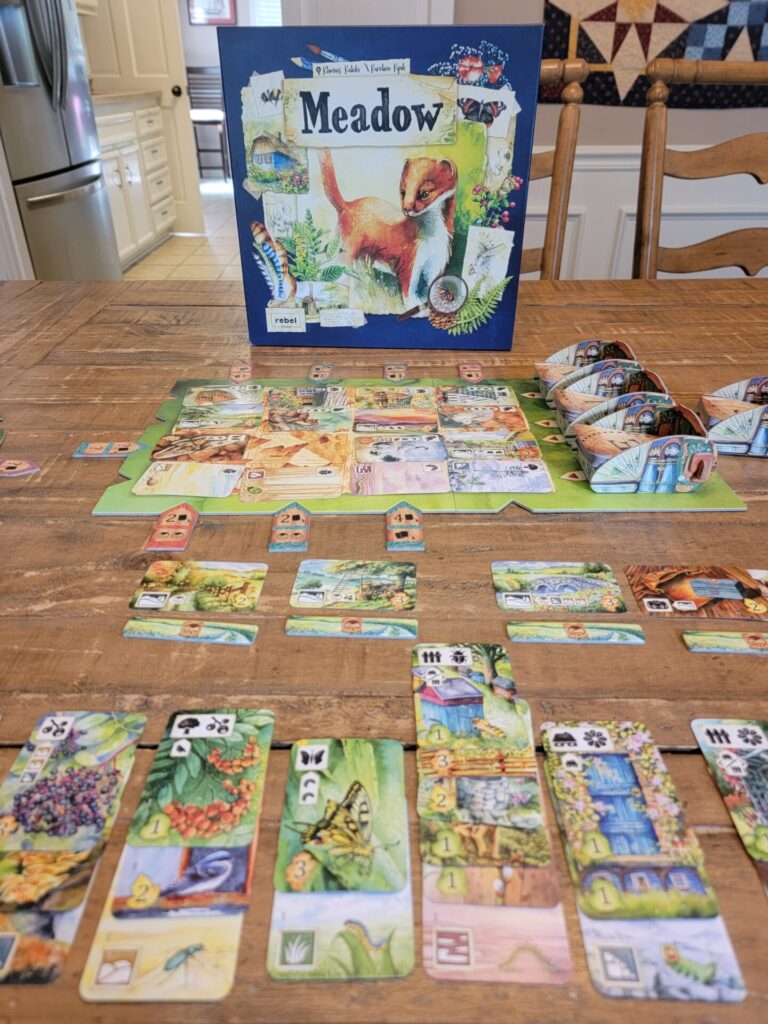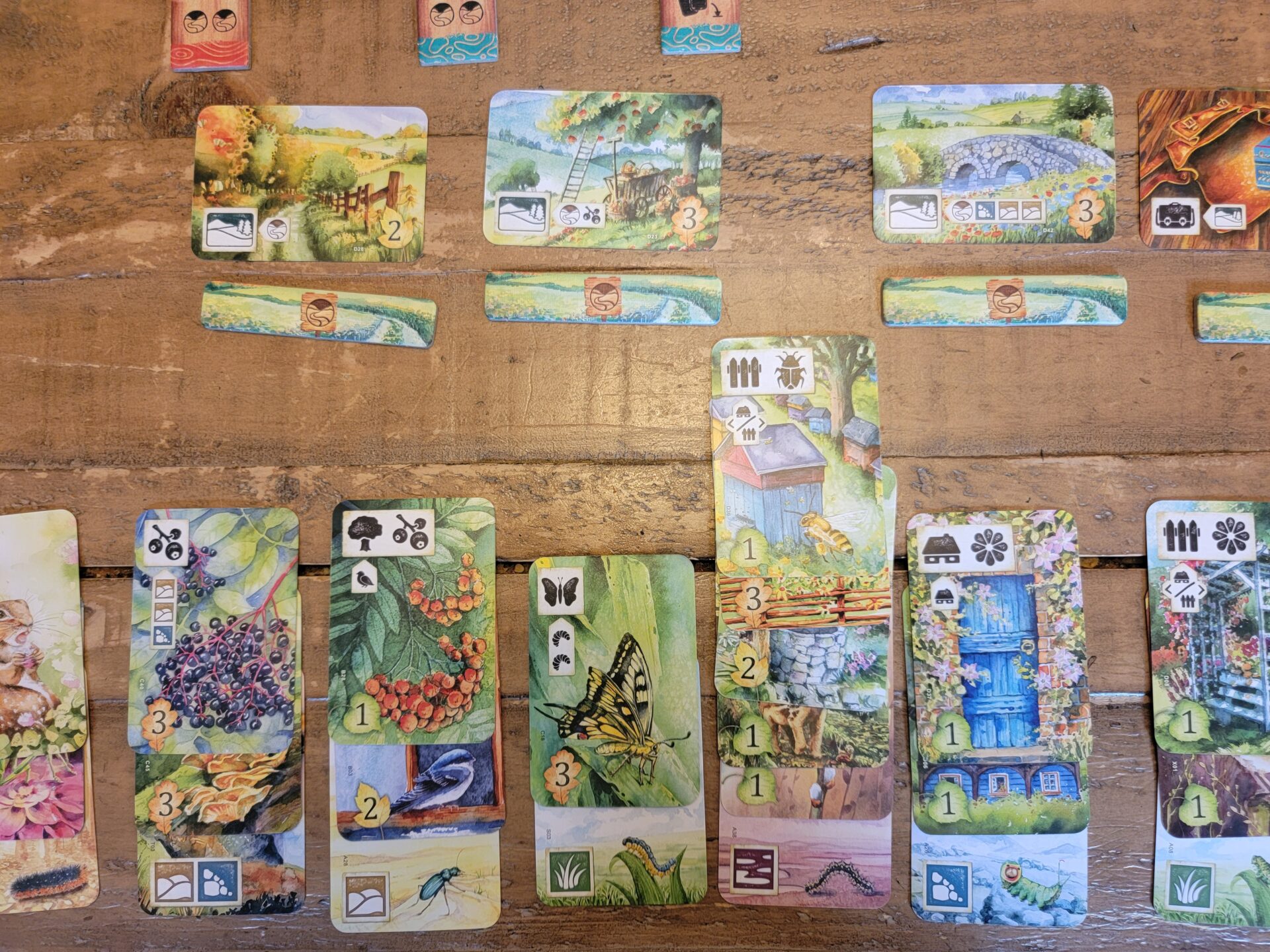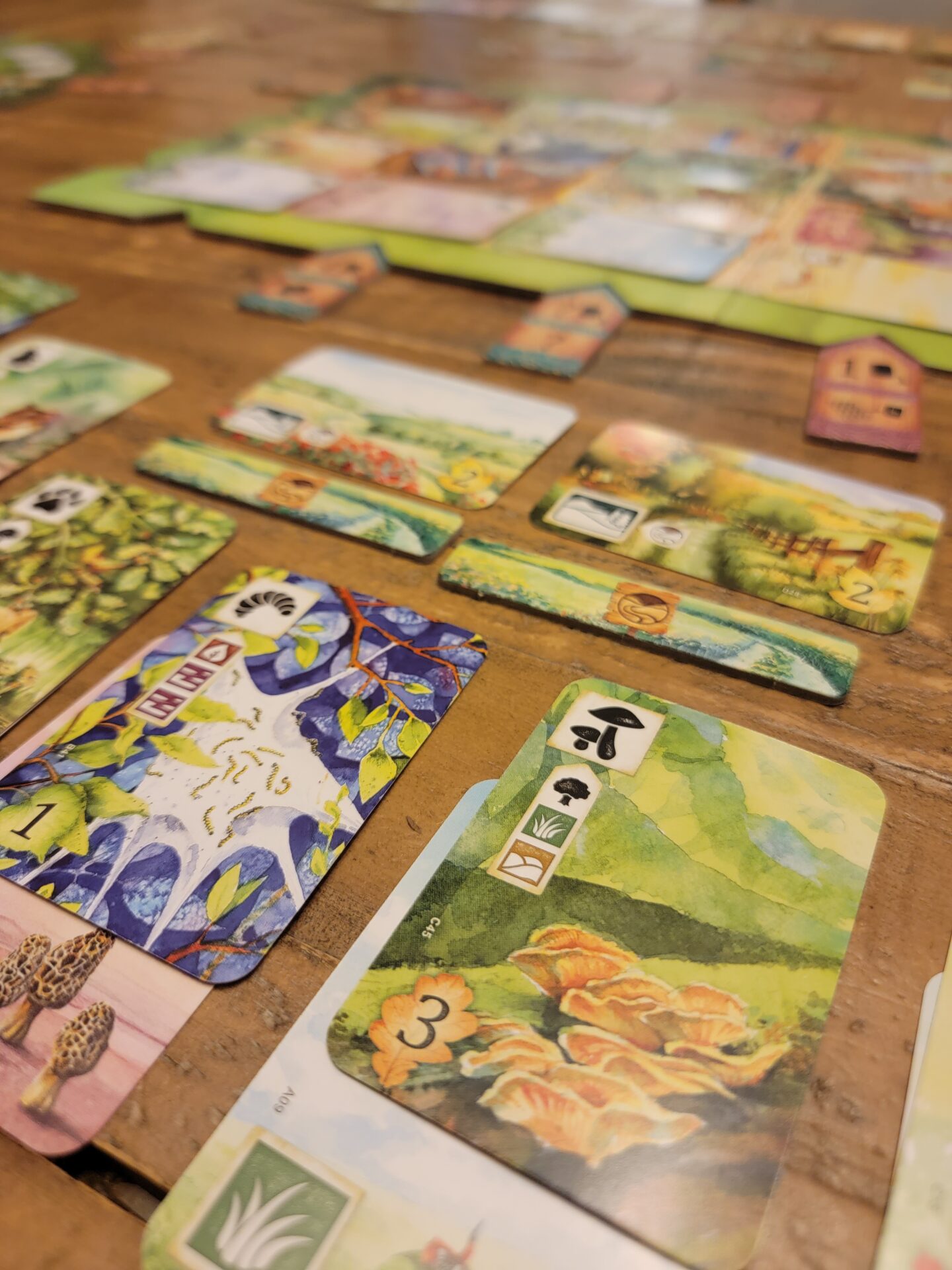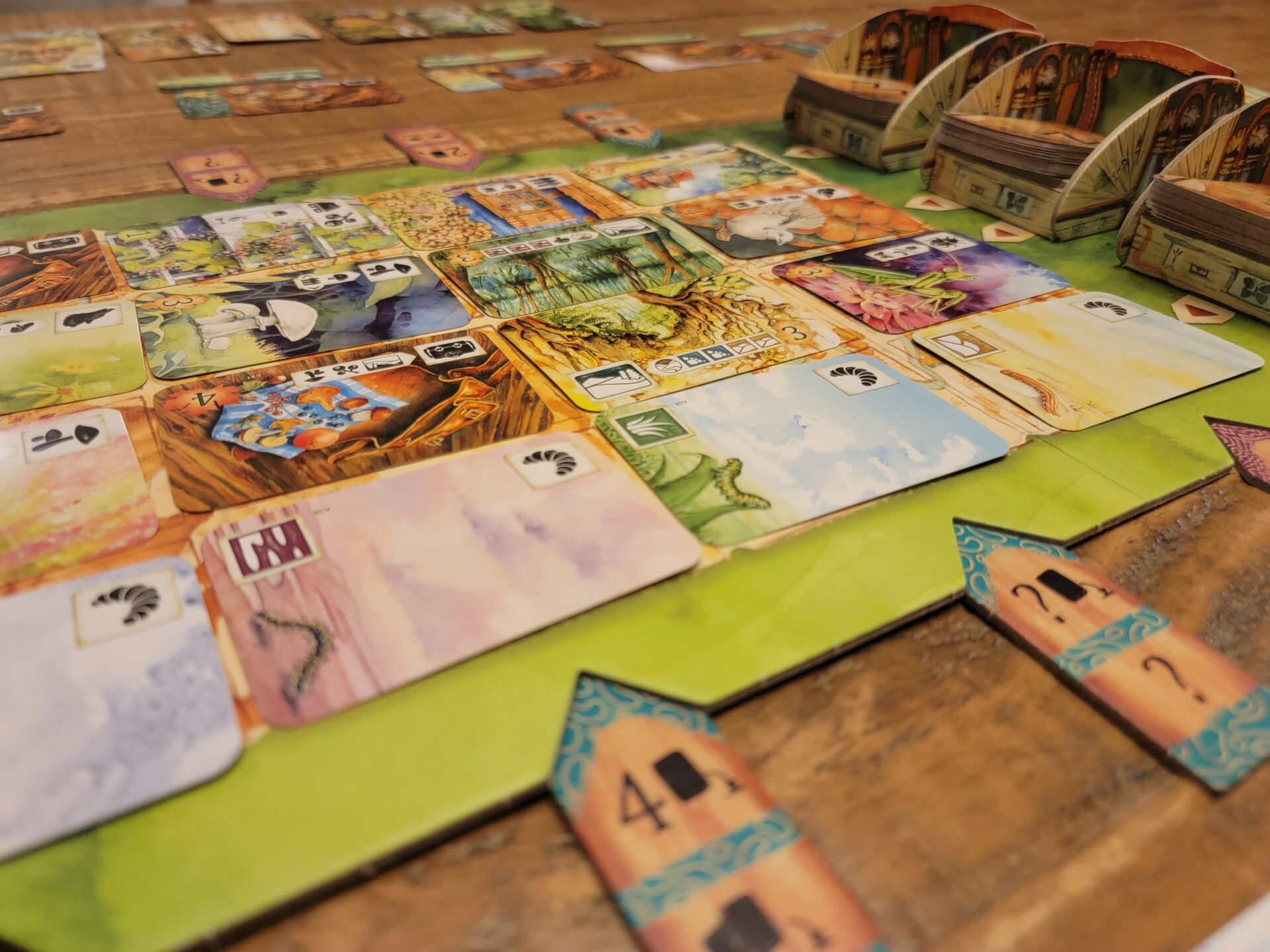
Name: Meadow
Year of Release: 2021
Player Count: 1 – 4
Playing Time: 60 – 90 Minutes
Designer: Klemens Kalicki
Publisher: Rebel Studios
Primary Mechanisms: Hand Management, Layering, Open Drafting, Set Collection
Weight (According to BGG.com): 2.23
Overview
I can’t think of a more pleasant place than where I am currently sitting, to complete my review on Meadow, a board game about observing the wonders, both big and small, of nature. I am residing on a high porch, perched over a babbling creek and surrounded wooded area. Just this morning, my wife saw a deer lazily wandering right by our bedroom window. Unfortunately, I was still asleep but not all of us like to wake up at 5:30 am to start exercising, especially on vacation!
Over the past year, Meadow’s theme, striking water-color artwork, and light weight has helped it to slowly ascend in popularity. While it hasn’t reached the heights of games such as Wingspan, you can find it at many big box stores like Target or Wal-Mart, nonetheless. Nature games generally pique my interest, but would Meadow’s low complexity stop it from becoming a favorite in our house? And would the solo mode (which is becoming more and more important in my gaming life) rise to the challenge of keeping me interested and calling me back for repeated plays?
Read on to find out!
Rulebook & Components
As a game that is seemingly being marketed towards the masses, I tried to look at the rulebook from an angle of a casual consumer of board games. Whereas myself, and a lot of you reading, might be used to combing through massive tomes of rules and game intricacies, a casual gamer probably isn’t and a bad rulebook is going to be the first barrier of entry to enjoying this hobby.
The rulebook for Meadow is 15 pages, full of colorful examples and informative hints. The length of the rules actually surprised me a bit as I thought it rather large for what I was expecting at this weight and wonder if it might be a turn-off to those coming into the hobby for the first time. Hopefully newer players won’t be intimidated by something bigger than the normal 2-page party game instructions, because the rulebook itself is laid out in a wonderfully instructive way, that will get players up and gaming quickly. It deftly describes the difference between the actions players can take at both the Main Board and the Campfire Board and explains the rules in playing the four different kinds of cards: Ground Cards, Observation Cards, Landscape Cards, and Discovery Cards. The solo mode has 2 pages dedicated to it at the end of the book and is a concise rundown of what changes to make in order to enjoy the game against the AI Player, Rover.
With Meadow being more a “card game” than a “board game”, the majority of the components you’ll be getting will be the 184 cards, comprised of the four types of named above, but also being split into four different decks, each labeled with one of the Cardinal Directions. The artwork is absolutely stunning, with each card depicting a different vignette, beautifully painted in watercolors by Karolina Kijak. The cards are also emblazoned with the game’s iconography, typically in the top left corner or bottom left corner. Most of these are printed in black and white so they clearly pop from the colorful displays behind them. All-in-all, the graphic design and illustrations on the cards is one of the high points of getting Meadow to the table.
Besides the 184 cards, there are a few other standouts with the components, the main draw being the four Foldable Deck Holders. These are four cardboard structures you’ll put together to hold the N, S, E, and W decks. I love how the bottoms are angled upwards slightly to facilitate smooth card handling and makes switching out the N and S decks at mid-game a breeze. Both the Main Board and Campfire Board are simplistic in their nature but utilize some interesting cut-out areas for action execution which raises these above the normal fold-out boards most players are familiar with. The rest of the components are varying cardboard tokens, typically printed in one of four vibrant colors, and while nothing too extraordinary, they meet the needs of the game.

Setup and Gameplay
In Meadow, setup is dependent on two variables: 1.) did you separate the cards when cleaning up your last game and 2.), how many players are playing? Obviously in a card game, shuffling is a needed part of setup and Meadow is no different. Players will shuffle the four decks separately and then load each into one of the Foldable Deck Holders, placing the W, S, and E in the four slots on the board. The N deck holder is placed to the side to be used at the half-way point. Cards are then drawn from each deck, placed into the rows and columns printed on the board, to create a 4×4 matrix of sixteen cards.
Players are given two Campfire Boards, both double sided, to manage any of the four player counts available in Meadow. You will select the board and side depending on your current player count, and then load the board with the necessary amount of Basic Goal Tokens. These are a set of Icons surrounding the campfire that give the players different combinations they can collect in their meadow for a shot at extra points. Lastly, each player will take the Path Tokens and Bonus Tokens in their player color and one Road Token. The Path Tokens are interesting in that one side is triangular shaped and one side is flat. The triangular side fits into the Main Board and facilitates where in the matrix the player would like to draw cards. Conversely, the flat side of each token displays a different action that can be executed when slotted into one of the few openings on the Campfire Board.
So, how does this all come together in the gameplay, and just what exactly is a player trying to do? Typically, players will be inserting their Path Tokens’ triangular side (printed with a number) into one of the 12 openings around the three sides of the Main Board. The player will then count the same number as is printed on the token from that side of the board, and draw the appropriate card to add to their hand. The rub is that each slot can only hold one Path Token so as the round progresses, a player might be locked out of all the available options to draw a particular card. If you’ve ever played a worker placement game, you’ll have an understanding of exactly how this mechanism works.
Ok, you’ve drawn a card, now what? In front of each player, he/she will be laying out cards in columns (up to 10) to form their personal Meadow. Observation cards will typically have some requirements printed on them, telling the player what they must have somewhere showing in their tableau and this also controls what column a player can position that card in. Once placed, the cards cascade, covering up the icon on the card below it so that only the top card in each column has a playable icon showing. If a Ground Card is drawn, it allows the player to start a new column and it’s icon (shown in the bottom left) will always be visible, differing slightly from the Observation Cards.
There are also Landscape Cards, that are similar to Observation Cards but have horizontal artwork instead of vertical artwork. These cards are placed in an area, called the Surrounding Area, which is outside of your personal Meadow. These cards need Road Tokens to be played in conjunction with them to get to the table but once played, Discovery Cards (illustrating different artifacts you might find on your wanderings) can be played on each Landscape Card to earn extra points.
At this point, you might be thinking, “what if there aren’t any slots available to help me get the card I really need?” This is where the flat side of the Path Tokens and the Campfire Board comes in. A player can choose to put a flat end of their token into the Campfire Board, triggering a specific action. These actions vary but include getting to take any card from the matrix or playing two cards in a single turn. In addition, once the token is placed by the player, in the same turn they can attempt to place a Bonus Tile around the campfire. In order to complete this objective, they need to have two of the icons (located next to each other at the campfire) visible in their tableau at that moment. If so, they can grab that spot with a Bonus Tile, earning them points at the end of the game and locking other players out of scoring that specific combination in the future.
Play progresses like this for a number of rounds (dependent on player count) before ending with the only big change happening mid-way through the game. At this point, the whole tableau is refreshed, and all the S cards are removed from the matrix, instead being replaced by the N deck. This deck has some more complicated combinations but typically rewards players with higher points per card. One all rounds are over, everyone simply sums up the victory points on all of their cards within both their Meadow, their Surrounding Area, and the Campfire Board, to figure out the winner.

Solo Mode Thoughts
As an avid solo gamer, purchasing games with dedicated solo modes is an important aspect of choosing a game for me. At the same time, I understand that the solo mode is probably going to be more of an afterthought for designers as bringing players together to share special moments is an important aspect of the hobby itself. For me, the solo mode to Meadow is just, “OK.” My main reason for feeling this way is that the AI player, Rover, is purely drawing cards at random and then just placing them in their stack for end game scoring. There is no actual intelligence or decision making behind Rover’s decisions. Positively though, this does make for a quicker game and an easier way to get Meadow to the table if you are alone but just really itching to see the beautiful artwork of the cards.
Conclusion

Honestly, I think Meadow has all the dimensions to become a household name in board gaming. The use of drawing and playing cards will be familiar to most, with the slight puzzle of how to construct your Meadow being a draw for those looking for something a little more complicated than their average party game. For non-casual gamers, this might be too light to get to the table very often but is still a relaxing and fun way to spend an hour, while being reminded just how special the world around us is.
Rating
Ratings are based on 5 main criteria: rulebook, setup, components, art & graphic design, and gameplay. The first 4 criteria are rated 1 to 5 and the gameplay is rated 1 to 10. These scores culminate in an “overall satisfaction” score that is rated from 1 to 10. If the reviewed game has both a solo and multiplayer mode, I have assigned scores separately to give context to which mode we enjoy more.
Links
As an Amazon Associate I earn from qualifying purchases.

